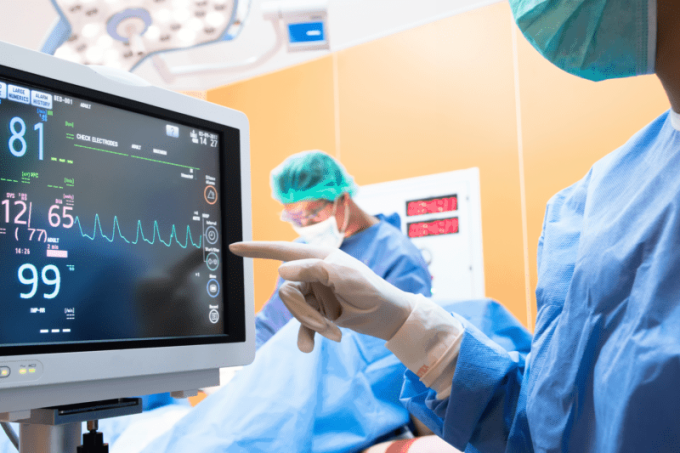A brand new synthetic intelligence algorithm can reliably display screen chest X-rays for greater than a dozen sorts of illness, and it does so in much less time than it takes to learn this sentence, in line with a brand new examine led by Stanford College researchers.
The algorithm, dubbed CheXNeXt, is the primary to concurrently consider X-rays for a large number of doable maladies and return outcomes which are in step with the readings of radiologists, the examine says.
Scientists skilled the algorithm to detect 14 completely different pathologies: For 10 illnesses, the algorithm carried out simply in addition to radiologists; for 3, it underperformed in contrast with radiologists; and for one, the algorithm outdid the specialists.
“Often, we see AI algorithms that may detect a mind hemorrhage or a wrist fracture — a really slim scope for single-use instances,” says affiliate professor of radiology Matthew Lungren. “However right here we’re speaking about 14 completely different pathologies analyzed concurrently, and it’s all by way of one algorithm.”
To learn all 420 X-rays, the radiologists took about three hours on common, whereas the algorithm scanned and recognized all pathologies in about 90 seconds.
The objective, Lungren says, is to finally leverage these algorithms to reliably and shortly scan a variety of image-based medical exams for indicators of illness with out the backup {of professional} radiologists. And whereas that will sound disconcerting, the expertise might finally function high-quality digital “consultations” to resource-deprived areas of the world that wouldn’t in any other case have entry to a radiologist’s experience. Likewise, there’s an essential function for AI in absolutely developed well being care techniques too, Lungren says. Algorithms like CheXNeXt might sooner or later expedite care, empowering major care medical doctors to make knowledgeable selections about X-ray diagnostics sooner, with out having to attend for a radiologist.
“We’re looking for alternatives to get our algorithm skilled and validated in a wide range of settings to discover each its strengths and blind spots,” says Stanford graduate scholar Pranav Rajpurkar. “The algorithm has evaluated over 100,000 X-rays thus far, however now we wish to know the way effectively it will do if we confirmed it 1,000,000 X-rays — and never simply from one hospital, however from hospitals around the globe.”
Observe makes excellent
The diagnostic algorithm has been in growth for greater than a yr. It builds on the work on a earlier iteration of the expertise that would outperform radiologists when diagnosing pneumonia from a chest X-ray. Now, the algorithm can flag 14 illnesses, together with plenty, enlarged hearts and collapsed lungs. For 11 of the 14 pathologies, the algorithm made diagnoses with the accuracy of radiologists or higher.
Again in the summertime of 2017, the Nationwide Institutes of Well being launched a set of a whole lot of hundreds of X-rays. Since then, there’s been a mad sprint for pc scientists and radiologists working in synthetic intelligence to ship the very best algorithm for chest X-ray diagnostics.
The scientists used about 112,000 X-rays to coach the algorithm. A panel of three radiologists then reviewed a unique set of 420 X-rays, one after the other, for the 14 pathologies. Their conclusions served as a “floor fact”—a prognosis that specialists agree is probably the most correct evaluation—for every scan. This set would finally be used to check how effectively the algorithm had discovered the telltale indicators of illness in an X-ray. It additionally allowed the staff of researchers to see how effectively the algorithm carried out in comparison with the radiologists.
“We handled the algorithm prefer it was a scholar; the NIH information set was the fabric we used to show the scholar, and the 420 photographs had been like the ultimate examination,” Lungren says. To additional consider the efficiency of the algorithm in contrast with human specialists, the scientists requested a further 9 radiologists from a number of establishments to additionally take the identical “remaining examination.”
“That’s one other issue that elevates this analysis,” Lungren says. “We weren’t simply evaluating this towards different algorithms on the market; we had been evaluating this mannequin towards working towards radiologists.” What’s extra, to learn all 420 X-rays, the radiologists took about three hours on common, whereas the algorithm scanned and recognized all pathologies in about 90 seconds.
Stanford is engaged on a subsequent model of CheXNeXt that may convey the researchers even nearer to in-clinic testing. The algorithm isn’t prepared for that simply but, however Lungren hopes that it’s going to finally assist expedite the X-ray-reading course of for medical doctors diagnosing pressing care or emergency sufferers who are available in with a cough.
“I might see this working in just a few methods. The algorithm might triage the X-rays, sorting them into prioritized classes for medical doctors to overview, like regular, irregular or emergent,” Lungren says. Or the algorithm might sit bedside with major care medical doctors for on-demand session, he says. On this case, Lungren says, the algorithm might step in to assist verify or forged doubt on a prognosis. For instance, if a affected person’s bodily examination and lab outcomes had been in step with pneumonia, and the algorithm recognized pneumonia on the affected person’s X-ray, then that’s a fairly high-confidence prognosis and the doctor might present care instantly for the situation. Importantly, on this state of affairs, there could be no want to attend for a radiologist. But when the algorithm got here up with a unique prognosis, the first care physician might take a better take a look at the X-ray or seek the advice of with a radiologist to make the ultimate name.
“We must be constructing AI algorithms to be pretty much as good or higher than the gold commonplace of human, skilled physicians—I’m not anticipating AI to switch radiologists any time quickly, however we aren’t actually pushing the bounds of this expertise if we’re simply aiming to boost present radiologist workflows,” Lungren says. “As an alternative, we have to be excited about how far we are able to push these AI fashions to enhance the lives of sufferers anyplace on this planet.”
Sustain with newest protection on digital healthcare by signing up for Web Well being Administration Information at the moment.
Favourite





